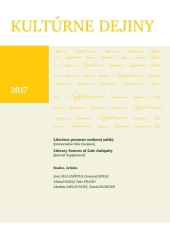Počet prenasledovaní kresťanov do constantinovského obratu v dielach raných kresťanských historikov a kronikárov vo svetle eschatologického myslenia
The Number of Persecutions of Christians before the Constantinian Shift in the Works of Early Christian Historians and Chroniclers in the Light of the Eschatological Thought of Early Christians
Author(s): Emanuel JirkalSubject(s): History
Published by: VERBUM - vydavateľstvo Katolíckej univerzity v Ružomberku
Keywords: Roman Empire;Late Roman Empire;Christianity;persecution of Christians;historiography;eschatological concepts
Summary/Abstract: The present paper seeks to address an interesting fact that we encounter in studying Christian sources about the persecutions of Christians by the Roman Empire. In these sources two methods of calculating a number of persecutions had crystallized. Based on them, there were either ten or seven persecutions. In order to better understand this, it is necessary to have an idea of the early Christian concepts of history and its end. Therefore, our interpretation also contains the Christian eschatological and apocalyptic thought with its concepts of the end of the world. A characteristic feature of these concepts is an idea of the eschaton being preceded by the last great persecution of God’s people. The paper focuses on important Christian historians, such as Eusebius of Caesarea, Lactantius, Jerome, Orosius, but also on nameless Christian chronicles. It tries to explain why they contain these numbers of persecutions.The paper is devoted to the concepts of Christians of the relationship between the state and the Church before the Constantinian shift that was a significant turn in this relationship. Many Christian authors mainly dealt with the repressive aspects of the Roman Empire in relation to the Christians. This side of the Empire manifested itself in varying degrees of oppression, culminating in a number of persecutions of Christians in which many of them perished.In his work entitled The Church History, Eusebius of Caesarea arranged the topics from the histories of church communities in chronological order and according to the reigns of individual Roman emperors, creating a good basis for the awareness of the periods of oppression and the times of the peaceful co-existence of the state and Christians. In his work, it was possible to look up and, subsequently, to begin to count the persecutions of Christians that they perceived as the state’s intervention against them. The first to do so was Jerome, the author of the Latin translation of the Bible – Vulgate, in his Chronicle that is a Latin translation and subsequent addition to Eusebius’s chronicle. Later, other Christian historians and chroniclers followed in the footsteps of Jerome.As a result, two ways of counting of the persecutions of Christians emerged, with ten persecutions according to the first way and seven based on the second one. It is interesting to look at the motives of individual authors who chose one of these numbers of persecutions. Both of these groups could rely on the rich symbolism hidden in these numbers, either traditional ancient or, in particular, biblical. Both numbers are considered to be the numbers of perfection, fulfilment and completeness, so the basic message of both numbers of persecutions is a realization that they are over and the Christians are not going to be persecuted any more, with the only exception being the last persecution at the end of times. Such counting was based on the eschatological and apocalyptic dimension of the Christian historical thought, as history is heading towards its goal which is the second coming of Jesus Christ and the establishment of the Kingdom of God. In describing the end of times, Nero often acted as the last persecutor and announcer of Antichrist who would eventually be defeated by Son of God, Jesus Christ. This was happening because he was also perceived as the first persecutor of the Christian Church.In the main part of the work, the author analyses the works by individual authors - Eusebius, Lactantius, Jerome, Orosius and chroniclers, and shows how many persecutions they counted or recorded. Interestingly enough, only some of the emperors occur in all the works. There are always Nero, Decius, Valerian and Diocletian. The others are interchangeable. Evidently, the persons of persecutors were not so important, with the exception of those emperors who started the empire-wide persecutions. What is important for these authors are not real persecutions but the symbolism of the number they chose as a number fulfilling God’s plan. Accordingly, they record individual persecutions and persecutors. Much more important was the fulfilment of the chosen number of persecutions, whether ten or seven, which determined the selection of persecutors. Individual authors sought to show God’s plan with the world and the action of God in history by fulfilling the number of persecutions, whether their archetype were to be ten plagues of Egypt or seven seals, seven bugles or seven bowls of anger from John’s Apocalypse.
Journal: Kultúrne dejiny
- Issue Year: 8/2017
- Issue No: Supplem
- Page Range: 19-36
- Page Count: 18
- Language: Slovak

